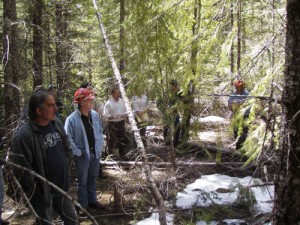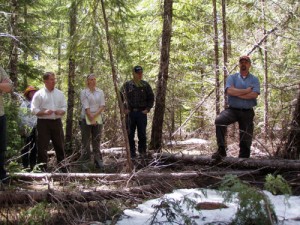At about 11 a.m. on a bright May morning, a group of people gather in a stand of Douglas fir trees in the Willamette National Forest. The site, called Woodpecker, is off Road 2200 in the Detroit Ranger District at an elevation of approximately 2,500 feet.
Standing in a circle are officials of the United States Forest Service, the North Santiam Watershed Council, representatives from the offices of U.S. Sen. Ron Wyden and U.S. Rep. Kurt Schrader and an eclectic mix of forest industry members, from moss and bough collectors to loggers and firewood merchants.
Surrounding the group is a grove of young trees in distress. The firs are crowded together, making it hard for sunlight to reach them. Competition for resources has made them susceptible to insects, disease, blowdowns and snow breakage.
The problem: Huge swaths of the
Willamette National Forest, perhaps as much as
12,000 acres, consist of stands of trees less than
40 years old that never have been thinned.
The trees, largely Douglas firs, are not
spaced properly, are in poor health and
pose a fire risk.
The grant: The National Forest Foundation,
a nonprofit partner of the United States
Forest Service, has provided a $24,000
grant to study the issue.
The grant expires in February.
Possible solution: The United States Forest Service,
in cooperation with the North Santiam
Watershed Council, is working with
companies in the region to establish a
special forest products industry to thin
the stands and harvest products such as moss,
boughs, posts and poles, logs and firewood.
What’s next: The Forest Service, the Watershed Council
and the North Santiam Chamber of Commerce are
encouraging businesses to form a cooperative
to take advantage of the commercial opportunities.
Who to contact: Forest Service, Detroit District:
Grady McMahan 503-854-4200 or [email protected];
Watershed Council: Liz Redon 503-930-8202 or
[email protected]
What’s the problem? Because of budget issues the stands, all composed of trees less than 40 years old, were never thinned. Trees that should be 13 to 14 feet apart are suffocating just eight feet from their neighbors.
It’s a problem that exists in hundreds of stands throughout the Willamette National Forest, perhaps totaling as much as 12,000 acres overall. And it’s a problem that could lead the way for a new approach to forest management and provide needed jobs for a long-embattled industry.
 The goal of the May 11 tour was fact-finding and listening. The key question: Can a special forest products industry be developed to thin the stands. The project is being funded by a $24,000 grant from the National Forest Foundation, the nonprofit partner of the Forest Service.
The goal of the May 11 tour was fact-finding and listening. The key question: Can a special forest products industry be developed to thin the stands. The project is being funded by a $24,000 grant from the National Forest Foundation, the nonprofit partner of the Forest Service.
“We’ve managed timber in the Willamette National Forest for 100 years, but we’ve never tried anything like this,” Forest Services Natural Resources Supervisor Darren Cross told the group. “We’re not trying to put things back. Instead we’re trying to imagine what (the forest) will look like in 30, 50 or 100 years.
“A traditional timber harvest is not workable. But what does different look like? This is not the way we normally do business in the Willamette National Forest. We normally do timber sales.”
Industry members, who came from as far away as Chehalis, Wash., offered plenty of questions and ideas.
How would sales be administered with multiple companies and industries involved? Who would take care of the debris, or slash, that would be left behind? Who gets access to the stand first? Could a cooperative of industry members be formed to work together on the project? And how quickly can regulatory issues be resolved so folks can get to work?
“Everything I got is riding on this,” said Mike Chastain of M&M Fire Fuels in Salem. “I like working in the district and working with you folks. Why can’t I just get in there and get to work? What can we do to get things along?”
“How can we get trees to the mill?” asked Tom Fenso of Mill City, whose family has been logging since the 1960s. “It’s hard to make it pay off in these small spaces. It takes time to get these logs out of here.”
There were more questions than answers, at least on this day. Forest Service officials admitted that perhaps new approaches to contracts would be required. Everyone grumbled about red tape.
“I’ve been dealing with the Forest Service for 28 years,” said Pat Mooney of Oregon Herb and Craft Products in Creswell. “I’m about to retire from it.”
The temperature had reached the low 70s by the time the group reached a second site, McCoy, off Road 2233 about 3,000 feet up on ground that still bore patches of snow.
The stand is a dreary, cluttered mess, with logs and debris littering the ground.
“This site has been stagnant since 1977,” said Susan Crowder, Special Forest Products Coordinator for the Forest Service. “It was planted in 1972 or 73. It’s just been sitting here stagnating. It needs help. Self-thinning is occurring and it’s not producing enough saw logs per acre.”
The Douglas firs were running at 1,000 per acre in McCoy, twice the level of the Woodpecker site, and five times the Forest Service goal of 200 per acre.
Chastain saw opportunities all around him.
“This could keep me busy for awhile,” he said. “It (firewood collecting) would reduce fuels on the ground by 60, maybe 80 percent. Slash piles would be nonexistent.”
Fenso, meanwhile, raised the litigation question.
“Why are there no environmental activists here, those likely to sue?” Fenso asked.
Grady McMahan, ranger for the Detroit District and Liz Redon, Contract Coordinator for the Watershed Council, said that representatives of environmental groups participated in a preliminary field trip last summer and had not expressed concerns about the approach.
Doug Heiken, Conservation and Restoration Coordinator for Oregon Wild, was present on that 2011 trip and offered cautious endorsement of the initiative in a telephone interview.
“Many aspects of that (approach) make a lot of sense,” Heiken said. “We’re generally in favor of that kind of early intervention in a stand. Every logging project has pros and cons. In young stands there are more pros than cons. But there is a limited supply of that cohort. And there are always issues to be concerned with, such as weeds and protecting streams.”
Amid the shadows of the McCoy stand the idea of a cooperative came up again.
“How many private companies are willing to step up and help?” Chastain asked. “I’ve got time, enthusiasm and the stupidity of youth. This is an opportunity to rebuild the forest products industry from the ground up. Why not re-invent this industry?”
Back at the Woodpecker stand earlier in the day Cross of the Forest Service had asked a similar question: “Why here? Why now?”
In the days following the tour, the North Santiam Chamber of Commerce issued a call for businesses to come forward and form a cooperative. So far, no one has stepped up to volunteer to lead such an effort, and it is unclear what will happen next.
McMahan said that future meetings are part of the plan to use the grant but that the next steps partly are dependent on what comes out of the May 11 tour. “We’ve waited for this for a long time,” McMahan said. “What are we going to do about these trees?”
Stay tuned. The clock is ticking on the grant. And the trees are not getting any healthier.
